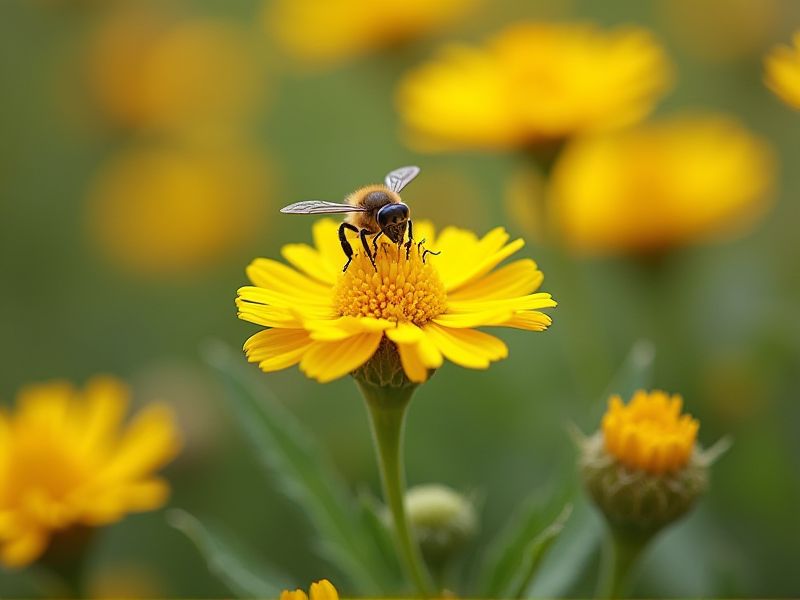
Incorporating bee-friendly plants into your garden can support pollinators while conserving water. Lavender (Lavandula) is a drought-resistant herb with vibrant purple flowers that attract bees and emits a calming fragrance. Another excellent option is the desert marigold (Baileya multiradiata), featuring bright yellow blooms that thrive in arid conditions and provide a reliable nectar source. Agastache, commonly known as hummingbird mint, is also an ideal choice, as it tolerates dry soil and offers tubular flowers that entice both bees and hummingbirds. By selecting these resilient plants, you can create a sustainable ecosystem that nurtures bees with minimal water usage.
List of some Bee-friendly plants that require little water
- Lavender (Lavandula)
- Russian Sage (Perovskia atriplicifolia)
- California Poppy (Eschscholzia californica)
- Coneflower (Echinacea)
- Blanket Flower (Gaillardia)
- Rosemary (Salvia rosmarinus)
- Sedum (Sedum)
- Rockrose (Cistus)
- Bluebeard (Caryopteris)
- Agastache (Agastache)
Important things about Bee-friendly plants that require little water
Native Plant Varieties
Native plants such as desert marigolds and penstemons are excellent options for creating bee-friendly gardens while conserving water. These drought-tolerant species provide essential nectar and pollen for pollinators like bees, supporting local ecosystems. In regions like the Southwest, plants like the agave and salvia can thrive with minimal irrigation, making them practical choices for sustainable landscaping. Incorporating these native varieties into your garden not only benefits bees but also enhances biodiversity and reduces water consumption.
Drought-Resistant Species
Drought-resistant bee-friendly plants, such as lavender, echinacea, and yarrow, thrive in low-water conditions while providing nectar and pollen for pollinators. These species not only conserve water but also enhance the biodiversity of your garden, attracting beneficial insects and supporting local ecosystems. Incorporating plants like sedum and agastache can significantly reduce water usage while ensuring a vibrant and buzzing environment. With proper selection, you can create a sustainable garden that nourishes both bees and your desire for eco-friendly landscaping.
Perennial Options
Choosing bee-friendly plants that thrive on minimal water can support both your garden and local pollinators. Plants such as lavender, sedum, and rosemary are excellent choices, attracting bees while requiring less irrigation once established. These drought-tolerant species not only conserve water but also provide essential nectar and pollen sources for honeybees and bumblebees throughout the growing season. By incorporating these plants into your landscape, you can create a sustainable environment that promotes biodiversity and aids in the health of bee populations.
Low Maintenance Requirements
Selecting bee-friendly plants that thrive on minimal water can significantly enhance your garden's biodiversity while conserving resources. Consider options like lavender, which attracts pollinators with its aromatic flowers and needs little irrigation once established. Similarly, sunflowers provide both beauty and sustenance for bees, flourishing in well-drained soil with infrequent watering. Incorporating these resilient plants into your landscape not only supports local ecosystems but also simplifies your gardening efforts by reducing maintenance needs.
Blooming Season Diversity
Bee-friendly plants, such as lavender, sedum, and yarrow, thrive during blooming seasons while requiring minimal water, making them ideal for sustainable gardening practices. These drought-resistant species not only attract pollinators but also contribute significantly to local ecosystems. Incorporating native plants like cone flowers and black-eyed Susans can enhance biodiversity, providing essential habitats and food sources for bees. Cultivating these plants helps to support environmental health and ensures your garden remains vibrant and buzzing with life.
Attractive To Pollinators
Bee-friendly plants such as lavender, California poppy, and yarrow not only attract pollinators but also thrive in low-water conditions. These drought-resistant species provide essential nectar and pollen needed by bees, encouraging biodiversity in your garden. By incorporating these plants, you can contribute to a sustainable environment while reducing your water usage. Choosing native varieties, like salvia or desert marigold, ensures that your garden effectively supports local bee populations and promotes ecological balance.
Deep Root Systems
Bee-friendly plants with deep root systems are essential for creating sustainable gardens that require minimal water. These plants, including purple coneflower (Echinacea purpurea), black-eyed Susan (Rudbeckia hirta), and desert sunflower (Geraea canescens), not only thrive in arid conditions but also provide vital nectar and pollen for bees. Their extensive root networks enable them to access moisture deeper in the soil, reducing the need for frequent watering while maintaining healthy growth. Incorporating these drought-tolerant, bee-attracting plants in your landscape promotes biodiversity and fosters a thriving ecosystem.
Sunlight Tolerance
Bee-friendly plants that thrive with minimal water and can tolerate sunlight include lavender, sage, and echinacea. These drought-resistant varieties provide essential nectar and pollen for bees, promoting biodiversity in your garden. Planting these species not only supports local bee populations but also reduces your water consumption, making them an eco-friendly choice. Consider adding these pollinator favorites to your landscape for a sustainable and vibrant garden that attracts beneficial insects.
Soil Adaptability
Bee-friendly plants that thrive in low-water conditions contribute significantly to sustainable gardening practices. Varieties such as lavender, salvia, and echinacea are not only drought-resistant but also attract pollinators, making them ideal for eco-conscious gardeners. Incorporating these plants into your landscape not only supports bee populations but also enhances the visual appeal of your garden with vibrant colors and scents. By selecting species that adapt well to local soil conditions, you can create a thriving ecosystem that benefits both plants and pollinators.
Pest Resistance
Bee-friendly plants that require minimal water, such as lavender, salvia, and echinacea, are essential for supporting pollinator health while conserving resources. These drought-tolerant species not only attract bees with their vibrant blooms but also enhance biodiversity in your garden. By incorporating such plants, you create a sustainable ecosystem that naturally resists pests, reducing the need for chemical interventions. This method not only fosters healthy bee populations but also promotes responsible gardening practices that benefit the environment.
